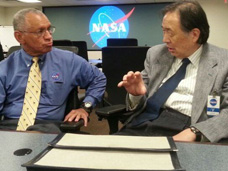Encapsulife's NASA-Inspired Technology
 Dr. Taylor Wang (on right) discusses diabetes cure and bio-artificial pancreas technology with NASA Administrator Charles Bolden.
Dr. Taylor Wang (on right) discusses diabetes cure and bio-artificial pancreas technology with NASA Administrator Charles Bolden.
Overview
Utilizing insights from compound droplet experiments performed by Dr. Wang in the microgravity environment of manned space flight, Encapsulife has developed a biomechanical immunoisolation system that protects cellular transplants and thus allows cell function and survival without the need for immunosuppression. This novel immunoisolation system consists of a multi-component, multi-membrane capsule that allows optimization of immune-protection, permeability, mechanical and chemical stability, and biocompatibility.
In recently published landmark research, allotransplantation of encapsulated islets were well-tolerated, biocompatible, and normalized the fasting blood glucose in 9 out of 9 dogs for up to four months with single transplant. Re-transplantation of encapsulated islets was effective in improving glycemic control for extended periods of time. This approach to encapsulation features reproducible parameters and procedures and should be applicable to diseases that could be treated by cellular transplants producing a biologic product.
Encapsulife's Multi-Component Membrane Capsule System
Encapsulife's new multi-component membrane capsule system is based on the same PMCG-CS /CACL2-Alginate membrane that Encapsulife successfully tested in small animal models in the 1990's. This membrane provides a proper balance between immunoisolation and mass transport. In addition, a novel thin interwoven membrane was introduced to reinforce the inner membrane. The strong ionic bonds of the novel system provides chemical stability, and the minute thickness (<1 micron) and the large pore size (~ 100 KDa) of this membrane do not alter the balance between immunoisolation and mass transport of the PMCG-CS /CACL2-Alginate membrane.
To improve the biocompatibility of the system, a third membrane of CACL2/Alginate system (~150 KDa) was added; this also provides additional mechanical strength for stability. This separation of functions of the three membranes offered flexibility in capsule design. In this way, each membrane performs one or two specific tasks and no single membrane is required to meet all the dichotomous requirements of a large animal model. The success of this process lies in the fact that each membrane chemically bonds with each other membrane; a small change in one membrane can alter the total performance of the capsule significantly. A detailed knowledge of what combination works and what does not is essential to the success of the system.
Thus, Encapsulife has designed a capsule that satisfies the dichotomous requirements, allowing nutrients to enter the capsule but preventing immune systems from attacking the cell. More importantly, in designing the capsule, Encapsulife considers the permeability, membrane thickness, mechanical strength, solute diffusion, and immuno-protection simultaneously. All parameters are independently adjustable. Therefore, Encapsulife can create systematic optimal capsule designs for different applications.
